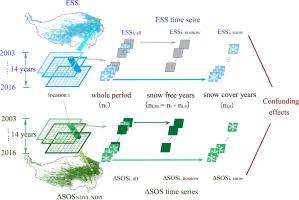Science of the Total Environment ( IF 9.8 ) Pub Date : 2020-11-21 , DOI: 10.1016/j.scitotenv.2020.144011 Ke Huang , Yangjian Zhang , Torbern Tagesson , Martin Brandt , Lanhui Wang , Ning Chen , Jiaxing Zu , Hongxiao Jin , Zhanzhang Cai , Xiaowei Tong , Nan Cong , Rasmus Fensholt

|
The Tibetan Plateau is the highest and largest plateau in the world, hosting unique alpine grassland and having a much higher snow cover than any other region at the same latitude, thus representing a “climate change hot-spot”. Land surface phenology characterizes the timing of vegetation seasonality at the per-pixel level using remote sensing systems. The impact of seasonal snow cover variations on land surface phenology has drawn much attention; however, there is still no consensus on how the remote sensing estimated start of season (SOS) is biased by the presence of preseason snow cover. Here, we analyzed SOS assessments from time series of satellite derived vegetation indices and solar-induced chlorophyll fluorescence (SIF) during 2003-2016 for the Tibetan Plateau. We evaluated satellite-based SOS with field observations and gross primary production (GPP) from eddy covariance for both snow-free and snow covered sites. SOS derived from SIF was highly correlated with field data (R2=0.83) and also the normalized difference phenology index (NDPI) performed well for both snow free (R2=0.77) and snow covered sites (R2=0.73). On the contrary, normalized difference vegetation index (NDVI) correlates only weakly with field data (R2=0.35 for snow free and R2=0.15 for snow covered sites). We further found that an earlier end of the snow season caused an earlier estimate of SOS for the Tibetan Plateau from NDVI as compared to NDPI. Our research therefore adds new evidence to the ongoing debate supporting the view that the claimed advance in land surface SOS over the Tibetan Plateau is an artifact from snow cover changes. These findings improve our understanding of the impact of snow on land surface phenology in alpine ecosystems, which can further improve remote sensing based land surface phenology assessments in snow-influenced ecosystems.
中文翻译:

积雪对从太空评估春季物候的混杂影响:对青藏高原趋势的重新审视
青藏高原是世界上最高和最大的高原,拥有独特的高山草原,并且在相同纬度下的积雪量高于任何其他地区,因此代表了“气候变化热点”。地表物候特征是使用遥感系统在每像素水平上描述植被季节性变化的时间。季节性积雪变化对土地表面物候的影响引起了广泛关注。但是,关于季节估计的积雪如何使遥感估计的季节开始(SOS)产生偏差尚无共识。在这里,我们从2003-2016年青藏高原的卫星衍生植被指数和太阳诱导的叶绿素荧光(SIF)的时间序列分析了SOS评估。我们通过实地观测和涡旋协方差对无雪和积雪站点的基于卫星的SOS进行了评估。来自SIF的SOS与现场数据高度相关(R2 = 0.83),并且归一化差异物候指数(NDPI)在无雪地区(R 2 = 0.77)和被雪覆盖的地区(R 2 = 0.73)均表现良好。相反,归一化植被指数(NDVI)与田间数据的相关性很弱(无雪R 2 = 0.35,R 2对于积雪覆盖的地点= 0.15)。我们还发现,与NDPI相比,雪季提前结束导致NDVI对青藏高原SOS的估计更早。因此,我们的研究为正在进行的辩论增加了新的证据,支持了以下观点:青藏高原上的地面SOS声称的进展是积雪变化的产物。这些发现增进了我们对雪对高山生态系统中地表物候学影响的理解,可以进一步改善受雪影响的生态系统中基于遥感的地表物候学评估。


























 京公网安备 11010802027423号
京公网安备 11010802027423号